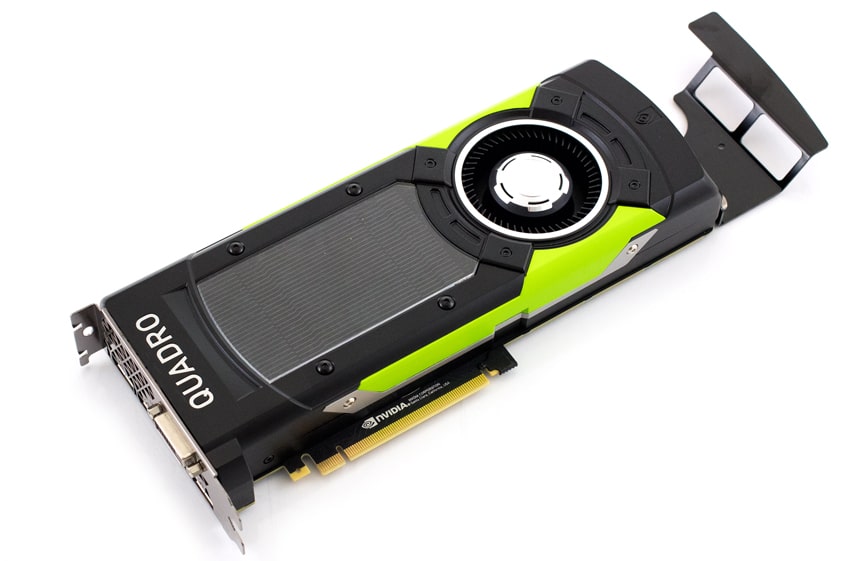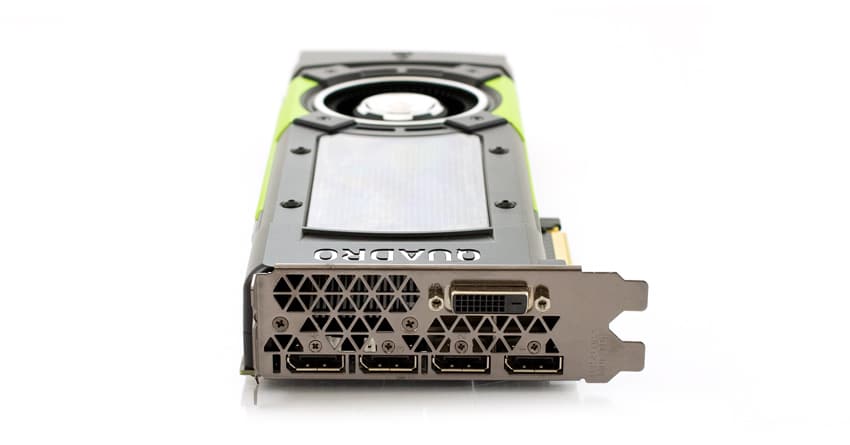
Unlike several vendors in the industry, NVIDIA likes to keep it a bit simpler in terms of naming their products. A higher number is equal to a higher performer. In our previous reviews we’ve looked at GPUs on the lower end of performance and how they perform in workstations. Today we will be looking at the NVIDIA Quadro P6000 the second most powerful (and possibly the highest performing) GPU NVIDIA has to offer for desktop workstations.

The P of the Quadro P6000 refers to its Pascal GPU architecture, which is built using a 16nm FinFET+ manufacturing process that in turn allows for more transistors, operate at higher frequencies, and deliver better performance per watt compared to prior generation GPUs. The new Pascal GPUs allow for more CUDA cores and larger framebuffers versus the older models and they leverage GDDR5X frame buffer memory (24GB in this case) supporting up to 9Gbps data rates.
So the question needs to be asked, what are users going to do with all of this graphic processing power? While the P6000 would work wonders with most media and creative professionals, it seems a bit like overkill. Dropping a P6000 in a system would add a bit a future-proofing in a rapidly changing industry (which is always useful to have), there is better use for it. As Virtual Reality (VR) technology continues to improve and become more mainstream there will be new opportunities in this field. The Quardro P6000 is ideal for creating and editing 3D VR content. Aside from gaming and design, VR is being implemented as a powerful tool in the medical and psychological communities and will most likely continue to grow in use cases and applications.
Just like the Quadro P5000, the P6000 measures 4.4” in height and 10.5” in length, and uses a dual slot via the PCI Express 3.0 x16 interface. It features the usual 4x 1.2 DisplayPorts as well as 1x DVI-I and an optional stereo port.
NVIDIA P6000 Specifications
- Architecture: Pascal
- CUDA Parallel Processing cores: 3840
- Peak Single Precision Performance: Up to 12 TFLOPs
- Frame Buffer Memory: 24GB GDDR5X
- ECC Memory: Yes
- Memory Interface: 384-bit
- Memory Bandwidth: 432GB/s
- Max Power Consumption: 250W
- Graphics Bus: PCI Express 3.0 x16
- Display Connectors: DP 1.2 (4), DVI-I (1), Optional Stereo (1)
- Maximum Supported Displays Channels Per GPU: 4
- Maximum Displays @ 4K 60HzChannels Per GPU: 4
- Form Factor: 4.4” H x 10.5” L Dual Slot
- Thermal Solution: Active
- NVIDIA 3D Vision and 3D Vision Pro: Support via 3 pin mini DIN
- Video Sync Module: Quadro Sync II
- GPU Direct for Video: Yes
Performance
To see just how powerful the NVIDIA Quadro P6000 really is, we installed the card inside our HP Z640 desktop workstation and put it through several graphics benchmarks. We will be comparing the P6000 to two other GPUs in the Pascal Quadro line, the P5000, and the P4000. This is not a one is better than the other, rather a look at performance progression from the mid-range to the high-end.
In our first benchmark, we will be looking at several aspects of the ESRI ArcGIS program; specifically, the average of the drawtime, average frames per second (Average FPS) and minimum frames per second (Minimum FPS).
Looking at drawtime, the P6000 hit 00:00:06.383 a little under the P5000 (06.412) and a little higher than the P4000 (06.342). In average FPS, the P6000 hit 515.79, just over the P5000 (513.15) and a bit more of the P4000 (499.66). For minimum FPS the P6000 hit 280.29 a bit higher than the P5000 (278.34) and just a hair under the P4000 (280.92).
| ESRI Benchmark | |
|---|---|
| Drawtime | Average |
| NVIDIA Quadro P6000 | 00:00:06.383 |
| NVIDIA Quadro P5000 | 00:00:06.412 |
| NVIDIA Quadro P4000 | 00:00:06.349 |
| Average FPS | Average |
| NVIDIA Quadro P6000 | 515.79 |
| NVIDIA Quadro P5000 | 513.15 |
| NVIDIA Quadro P4000 | 499.66 |
| Minimum FPS | Average |
| NVIDIA Quadro P6000 | 280.29 |
| NVIDIA Quadro P5000 | 278.34 |
| NVIDIA Quadro P4000 | 280.92 |
The next benchmark we will be looking at is the SPECviewperf 12, the worldwide standard for measuring graphics performance based on professional applications. SPECviewperf runs 8 benchmarks it calls viewsets, all of which represent graphics content and behavior from actual applications. These viewsets include CATIA, Creo, Energy, Maya, Medical, Showcase, Siemens NX, and Solidworks. During this test, the NVIDIA P6000 showed better performance than the other two GPUs across the board, significantly in the Medical, Showcase, and Siemens NX.
| SPECviewperf 12 | |||
|---|---|---|---|
| Viewsets | NVIDIA Quadro P6000 | NVIDIA Quadro P5000 | NVIDIA Quadro P4000 |
| catia-04 | 179.88 | 171.15 | 143.87 |
| creo-01 | 125.18 | 122.80 | 110.06 |
| energy-01 | 22.76 | 17.30 | 12.76 |
| maya-04 | 108.23 | 106.58 | 98.29 |
| medical-01 | 104.44 | 77.73 | 55.91 |
| showcase-01 | 143.42 | 102.47 | 82.93 |
| snx-02 | 272.86 | 214.56 | 156.07 |
| sw-03 | 190.92 | 188.09 | 157.43 |
Conclusion
The NVIDIA Quadro P6000 is the second to the top in the company’s Quadro line, just behind the GP100. The GPU is built off of Pascal GPU architecture (leveraging a 16nm FinFET+ manufacturing process) and packs many a component to give it its high performance including 24GB of GDDR5X frame buffer memory and 3,840 CUDA cores. While the P6000 would be able to handle just about any desktop graphic task thrown its way, the GPU is powerful enough to tackle the emerging and growing VR market.
In terms of performance, we looked at the upper end of the Quadro line through ESRI ArcGIS and SPECviewperf workloads. As expected, and as one can easily see, the performance went up as the model number went up. The P6000 really performed well in certain viewsets in SPECviewperf including Medical, Showcase, and Siemens NX.
The Bottom Line
The NVIDIA Quadro 6000 is a GPU that offers more than enough performance for most graphical use cases and in particular for users that are creating and editing 3D VR content.
Sign up for the StorageReview newsletter

